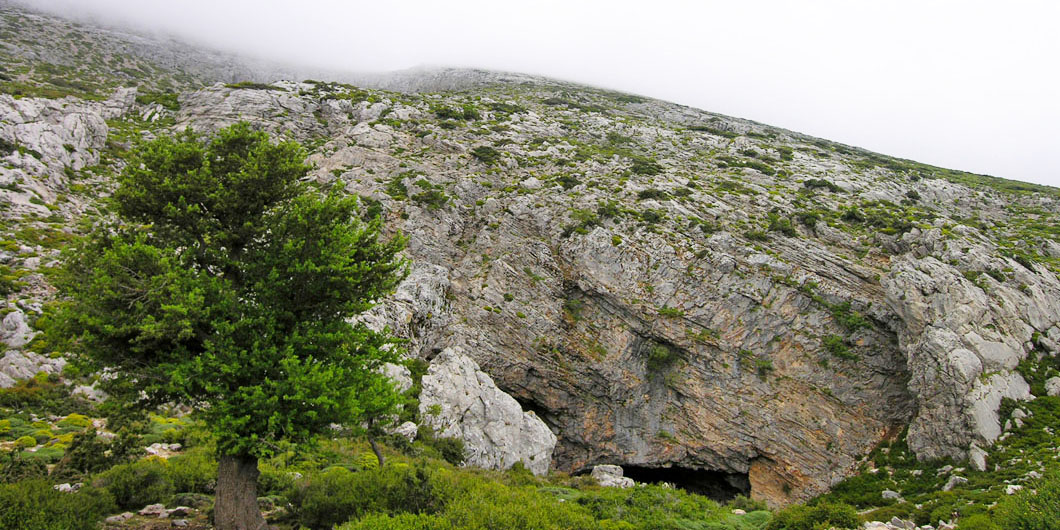This is considered the sacred cave of the Cretans, which was famous throughout the Hellenic world in Antiquity, and a great centre of worship and initiation. It is located on the western side of Nida plateau, at the foot of a steep slope, 1.538 metres up.

According to the myth,Zeus was born here, his cries covered by the sounds of the drums and the armed dances of the Idaean Dactyls (Idaioi Daktyloi), mythic demons in the service of the mother of Gods, Rhea, often identified with the Κοuretes and the Korybantes.
Information proving the importance of this cave as a place of worship comes from as early as the 15th century BC. Its reputation spread across the Hellenic world and thus it became one of the most important centres of religious studies in Antiquity. The purification and initiation ceremonies attracted a great number of worshippers, among whom were the great Greek philosophers Epimenedes and Pythagoras.
The initiation ceremonies were held in the Adyton, a section of the cave located high up on the western wall of its main hall, directly across from the huge entrance. The celebrations in honour of Zeus were associated with the regeneration of nature in spring.
At the entrance of the cave, a hewn-stonesacrificial altar can be seen. The importance of the cave is also verified by the extensive finds from the excavations, such as weapons and utility items, copper and clay figurines, artefacts made of bone and ivory, tripods and cauldrons, copper trays, drums and shields with elaborate representations.

All these are kept today in the Archaeological Museum of Heraklion. The first archaeological research was conducted by the Italian archaeologist Federico Halbherrafter 1884, when a shepherd from Anogia found the first ancient artefacts in the cave. Later, excavations were conducted by Stefanos Xanthoudides, Paul Faure and Spyros Marinatos.
The cave is also related to more recent folk traditions of the area, such as that of Charidimos and his wife, whom he accidentally killed while he was hunting on the forested Mount Ida.
The person who, having conducted a systematic excavation, which begun in 1983, contributed greatly to the forming of a more complete picture of the Idaeon Andron, is the archaeologist Yannis Sakellarakis, about which he has said:
“… The innumerable votive offerings, made of the most valuable materials, such as gold, silver, copper, ivory, semi-precious stones, as well as faience, rock crystal, glass, bone and clay, all in a great variety, pots and utensils, coins, seals and jewellery, can only be compared with those offered at other Pan-hellenic sanctuaries. The famous bronze shields from the IdaeonAndron are numbered among the finest works of art of the Ancient World.
Many are the imports from Egypt and the Syro-Palestinian coast, as well as from areas even further east. Craftsmen from northern Syria worked for the construction of the ivory throne of Zeus, which according to legend was seen by Pythagoras. Thousands of worshippers held oil lamps which were made in various Cretan workshops, and perhaps in other ones in Corinth, Attica, Italy and Egypt.

In the Idaeon Andron, evidence of life begins at the end of the 4th millennium BC, during the Late Neolithic Period, and has continued uninterrupted ever since.
Naturally, the sanctuary had its high points: in the Late Minoan I period (16th century BC), in the Geometric period, in the 8th century BC and in the Roman era. Even in the time of the Roman emperor Julian the Apostate (4th century AD), a certain Plutarch is reported to have boasted of being initiated into the Mysteries of the Idaeon Andron. In the 2nd millennium BC, the worship was centred on the Minoan god of vegetation, who was believed to die and be born again every year; that is why his descendant god, the Cretagenus Zeus (= Cretan-born Zeus), although for all other Greeks he was thought to be immortal, for the Cretans he would pass away every year in the Idaeon Andron and be subsequently reborn. Just like in nature, when all life ends in the winter, only to be born again in spring…”.
Geosite
The Ideon Cave is situated on the outskirts of the Nida Plateau, on the steep eastern slope of Mount Psiloritis, which forms the large fault of the region. Its entrance lies directly on the fault, and internally, parallel fault surfaces are also visible within the cave. At the entrance, which is slightly downhill leading to a large hall, as well as inside the cave, folds of platy limestones can be seen. The cave has been one of the most significant and enduring worship sites in Crete.
Traces of its use date back to the Neolithic period, while during the Minoan period, it was the most important religious site on the island, visited by the kings of Knossos every nine years. It was primarily dedicated to Zeus, and at the entrance, the carved altar still dominates. The religious use of the cave continued until the Roman period, and at times, it served as an oracle, perhaps due to gas emissions from the active adjacent fault. The rich findings from the cave excavated by Yiannis Sakellarakis are housed in the archaeological museums of Heraklion and Rethymno.
The geosite description is a result of the deliverable of the research project Joint Innovative Activities for Outdoor Tourism-JoinOut. The project entitled "Partnership of Innovative Rural Tourism Actions" and distinctive title: "JoInOuT", is implemented within the framework of the Action "Cooperative Innovation Formations/SCC" - 2nd Call: Businesses" and is financed by the European Regional Development Fund (ERDF) and by National Resources in the context of the Operational Program "Competitiveness, Entrepreneurship and Innovation (EPANEK)" of the NSRF 2014-2020" (Project code: ΓΓ2CL-0359457).








